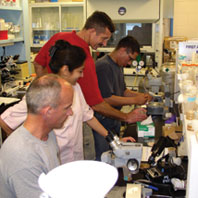 |
 |
|
 |
 |
 |
 |
 |
|
 |
 |
 |
 |

 |
 |
 |
 |

|
 |
Return to Table of Contents
NASA Astronauts Participate in Hands-On Science Training at the MBL
Four NASA astronauts from the Johnson Space Center in Houston were in residence at the MBL last summer taking part in “Science for Enabling Human Exploration,” a pilot program aimed at providing science background and laboratory training to astronauts for future missions on the International Space Station, the Moon, and eventually Mars.
 |
|
Astronauts honed their laboratory skills as part of the workshop.
|
|
The goal of the workshop, which took place from July 18 to August 6, was to enable the astronauts to play a new role in in-flight science. Currently astronauts get only 13 hours of science training and many don’t have formal education in the life sciences. This workshop increased their training to more than 150 hours.
Working out of MBL senior scientist Norman Wainwright’s laboratory, astronauts Dan Burbank, Tracy Caldwell, Jeff Williams, and Suni Williams (who are not related), were busy conducting experiments in the biomedical, biological, and physical sciences. Their hands-on training ranged from how to handle and use fruit flies (Drosophila) for space-related experimentation, to demonstrating the feasibility of electrochemical processing to produce metals and oxygen from Martian soil, to understanding the effects of spaceflight on the cardiovascular system. The workshop drew faculty and speakers from around the country, as well as from the MBL’s year-round and summer research communities.
Besides helping to hone their laboratory skills, the training program taught the astronauts how to look at data, interpret it, and serve as scientific collaborators. “The current [astronaut] participation is at the operator level, not at the contributor level,” said Daniel Barry, NASA astronaut and workshop director. “It is important to train astronauts in the scientific method. This is the first step toward increasing scientific curiosity in space.”
While it is uncertain whether the workshop will become a permanent part of NASA’s training program for astronauts, it is clear that the organizers were happy with their choice of the MBL as the location for the pilot program. NASA decided on the MBL for several reasons, but perhaps most importantly because it is a place where the world’s top biologists can come together and focus on their research, not distracted by departmental affairs, committee work, or other aspects of day-to-day university life. “The MBL provides both the resource support and the intellectual environment that enables many scientists to do their best work,” said Barry. “I couldn’t think of a better place in the world for this.”
|
|
| |
 |
|
 |
 |
|